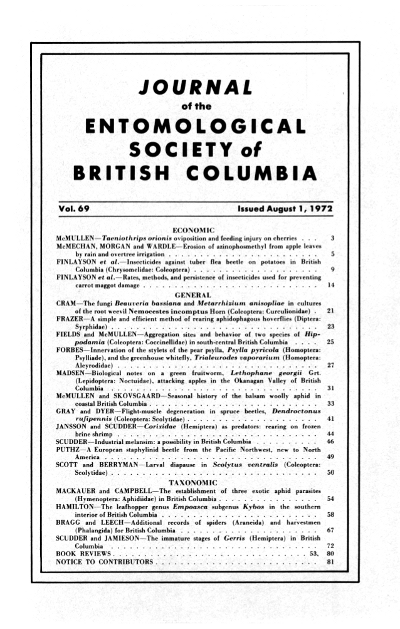Larval diapause in <i>Scolytus ventralis</i> (Coleoptera: Scolytidae)
Keywords:
<i>Scolytus ventralis</i>, Coleoptera, ScolytidaeAbstract
When <i>Scolytus ventralis</i> was reared under relatively constant temperatures 50-70% of the brood developed rapidly and emerged within 70 days. The remainder emerged gradually over the 130 days following the first emergence peak. Exposure to field conditions resulted in retarded emergence of the rapidly-developing proportion of the population and increased synchrony in the emergence pattern. Increasing exposures to cold temperatures in the field resulted in increased emergence synchrony, and a shorter developmental time when exposed to warmer temperatures in the laboratory. It was concluded that the rapidly-developing portion of the population may enter a facultative diapause while the remainder enters an obligatory diapause under normal field conditions.References
Scott, B.A. Jr. and A.A. Berryman. 1971. Laboratory rearing techniques for Scolytus ventralis (Coleoptera: Scolytidae). Wash. Agric. Expt. Sta. Bull 741. 9pp.
Struble, C.R. 1957. The fir engraver, a serious enemy of western true firs. U.S.D.A. Proc. Res. Rep. 11. 18pp.
Downloads
Published
Issue
Section
License
Authors who publish with the Journal of the Entomological Society of British Columbia agree to the following terms:
-Authors retain copyright and grant the journal right of first publication with the work simultaneously licensed under a Creative Commons Attribution License that allows others to share the work with an acknowledgement of the work's authorship and initial publication in this journal.
-Authors are able to enter into separate, additional contractual arrangements for the non-exclusive distribution of the journal's published version of the work (e.g., post it to an institutional repository or publish it in a book), with an acknowledgement of its initial publication in this journal.
-Authors are permitted and encouraged to post their work online (e.g., in institutional repositories or on their website) prior to and during the submission process, as it can lead to productive exchanges, as well as earlier and greater citation of published work (See The Effect of Open Access).


